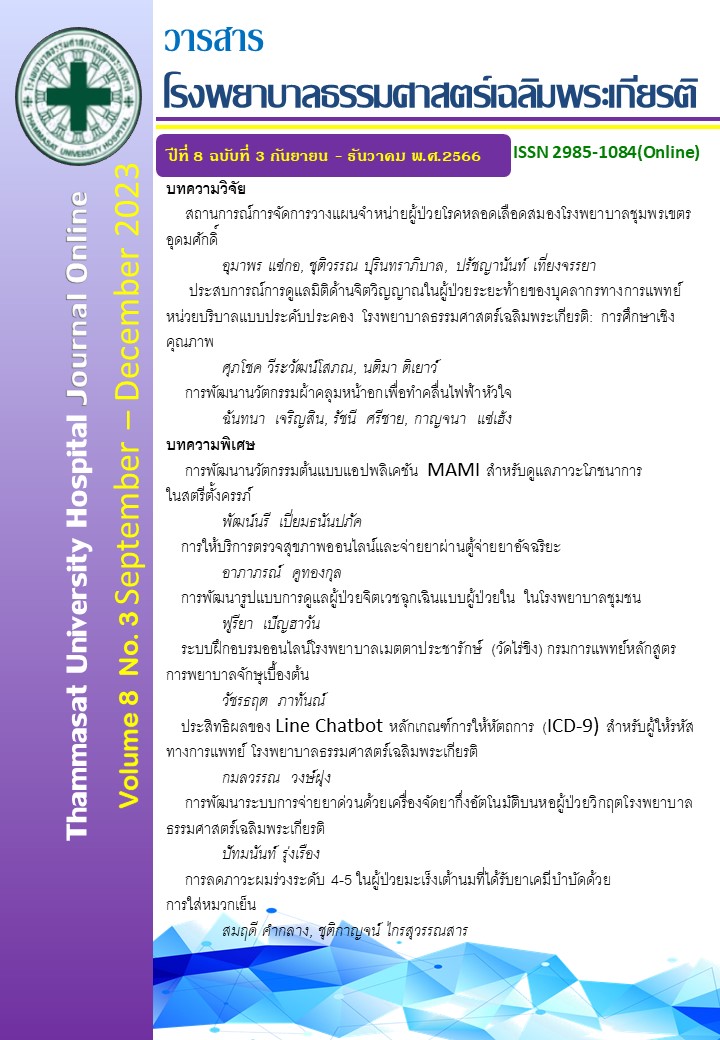Reducing alopecia in breast cancer patients undergoing chemotherapy with scalp cooling
Keywords:
Scalp cooling guideline, Hair Preservation, Alopecia, ChemotherapyAbstract
Introduction: Chemotherapy for breast cancer treatment may cause hair loss which leads to negative effects on the physical and mental status of the patients especially in their body image. Generally, the hair will regrow within 3 months after the completion of such agents. However, some regimens including docetaxel bring about long-term effects such as permanent hair loss (permanent alopecia) and this is one of the patient’s reasons for refusing chemotherapy. The Surgical Oncology Daycare Unit has provided scalp cooling cap to patients receiving chemotherapy which aim to reduce the degree of hair loss, increase the quality of life, enhance psychological support, and promote the image of patients.
Objective To reduce the level of hair loss (level 4-5) in breast cancer patients receiving chemotherapy to 50% within 12 months.
Methods 1) Educate the nursing team caring for breast cancer patients receiving chemotherapy with scalp cooling and improve work instruction. 2) Prepare a leaflet for patients undergoing scalp cooling. 3) Create gel support to decrease the gap between the mid part of the scalp and the cover cap. 4) Apply the facial strap to make the gel cap closer to the scalp. 5) Record the size of the gel cap and cover cap for each patient to identify individually.
Results: The hair loss in breast cancer patients receiving chemotherapy with scalp cooling decreased from 84.42% to 72.50%.
Conclusion The nursing guidelines for reduction of the hair loss in breast cancer patients receiving chemotherapy with scalp cooling have been developed. Work instruction was revised for assessing hair loss levels based on Sinclair's scale. The facial straps were applied to keep a cool gel cap attached to the scalp. Moreover, the self-care leaflet for patients and the guideline for assessing the level of hair loss have been conducted according to Sinclair's scale by demonstrating pictures of the hair grading system.
References
กลุ่มงานดิจิตอลการแพทย์ สถาบันมะเร็งแห่งชาติ. ทะเบียนมะเร็ง 2563 [อินเตอร์เน็ต]. กรุงเทพฯ: สถาบันมะเร็งแห่งชาติ กรมการแพทย์ กระทรวงสาธารณสุข; 2563 [เข้าถึงเมื่อ 13 ธันวาคม 2565 ] เข้าถึงได้จาก:https://www.nci.go.th/e_book/hosbased_2563/index.html
Kang D, Kim I-M, Choi E-K, Im Y H, Park, Y.H, Ahn J S, Lee J E, Nam S J, Lee H K, Park J-H, Lee D-Y, Lacouture M E, Guallar E, Cho J. Permanent Chemotherapy-Induced Alopecia in Patients with Breast Cancer: A 3-Year Prospective Cohort Study [Internet]. 2019 [Cited 2022 Dec 14]; 24: 414-420. Available from: https://www.ncbi. nlm.nih.gov/pmc/articles/PMC6519756/
El-Nemer A M, El-Zafrani M I, El-Say med H E, & Saadoon O H. Utilization of a self-care education program for alleviating chemotherapy induced physical side effects [Internet]. 2015 [Cited 2022 Dec 14]; 1: 8-16. Available from: https://www.researchgate.net/publication/276105125_Utilization_of_a_SelfCare_Educational_
Program_for_AlleviatingChemotherapy_Induced_Physical_Side_Effects
Llamas M. Breast Cancer Survivor Files Permanent Hair Loss Lawsuit [Internet]. 2022 [Cited 2022 Dec 14].Available from: https://www.drugwatch.com/beyond-side-effects/sanofi-hid-permanent-hair-loss-taxotere-chemo-drug-lawsuit/
ปิยมาศ สุวรรณลัดดา. ผลของการพยาบาลระบบสนับสนุนและให้ความรู้ร่วมกับการใช้หมวกเย็นคลุมหนังศีรษะต่อการหลุดร่วงของเส้นผมและความสามารถในการดูแลเส้นผมด้วยตนเองของผู้ป่วยมะเร็งรังไข่ที่ได้รับยาเคมีบำบัด [วิทยานิพนธ์ พย.ม. การพยาบาลผู้ใหญ่]. สงขลา: มหาวิทยาลัยสงขลานครินทร์;2561.
Boland V, Brady A M, Drury A.The physical, psychological and social experiences of alopecia among women receiving chemotherapy: An integrative Literature review [Internet]. 2020 [Cited 2022 Dec 14]; 49: 1-10. Available from: https://pubmed.ncbi.nlm.nih.gov/33120213/
Peethambaram P P, Loprinzi C L. Can Scalp Cooling Stop Hair Loss from Chemotherapy? [Internet]. American Society of Clinical Oncology (ASCO); 2019 [Cited 2022 Jan 24]. Available from: https://www.cancer.net/blog/2019-01/can-scalp-cooling-stop-hair-loss-chemotherapy
Paxman. A degree of control a guide to scalp cooling [Internet]. Hudderfield: 2022 [Cited 2022 Jun 28]. Available from: https://www.paxmanusa.com/wp-content/uploads/2018/01/Paxman-Patient_Brochure-Issue003.pdf
The NCCN Clinical Practice Guidelines in Oncology (NCCN Guidelines) Breast Cancer version 2. Invasive breast cancer BINV-L 1[Internet]. San fransisco: 2019 [Cited 2022 Dec 14]. Available from: https://www2.trikobe.org/nccn/guideline/breast/english/breast.pdf
Paxman. The NCCN Guidelines now recommend scalp cooling as a category 2A treatment option for patients with invasive breast cancer [Internet]. Hudderfield: 2019 [Cited 2022 Jun 27]. Available from: https://www.paxmanusa. com/news/the-nccn-guidelines-now-recommend-scalp-cooling/
Sinclair R D. Female pattern hair loss: a pilot study investigating combination therapy with low-dose oral minoxxidil and spironolactone [Internet]. 2018. [Cited 2022 Dec 14]. Available from: https://pubmed.ncbi.nlm.nih.gov/29231239/
Downloads
Published
How to Cite
Issue
Section
License
Copyright (c) 2023 Thammasat University Hospital Journal Online

This work is licensed under a Creative Commons Attribution-NonCommercial-NoDerivatives 4.0 International License.


